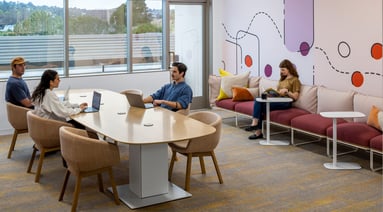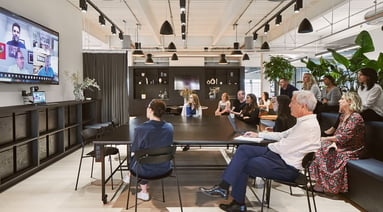Four workplace strategies to help bridge the disconnect between employers and employees

A recent HR.com article explores the disconnect between what employees want in the workplace and leader perceptions, and the role of HR in creating environments that support their people.
In our Global Workplace Insights report Returning for Good, data from over 16,000 employees and employers indicated there’s a significant disparity between employers and employees’ perceptions of the office. Although many employers are enforcing office mandates with the assumption that their workforce will be more effective, the research is telling a different story. Today’s workplaces aren’t set up to meet employee needs, which is affecting staff retention, productivity, and satisfaction.
So, how can companies bridge the disconnect?
1. Creating two-way communication
Employers are placing a high value on the workplace, but employees are missing the memo. In fact, 88% of employers state that remote workers will face limitations in terms of promotions, salary raises, and bonuses if they don’t return, but only 67% of employees believe this is true.
To get on the same page, employers must communicate their expectations for in-office time and make sure the workplace supports their employees. If leaders align their goals with their workforce, they may be more willing to come into the office by choice.
2. Enabling productivity
Whether employees are meeting remotely or in person, the experience needs to be equitable and productive. 73% of leaders have seen decreased engagement in virtual meetings, but 58% of employees say when they’re in the office, distractions and excessive meetings make it difficult to complete tasks.
By adapting your office design to include integrated technology and offering a variety of space types with different treatments and features, employers can improve engagement and productivity, and create spaces where everyone feels welcome and included.
3. Being flexible
Employees are coming back into the office, but not by choice. 42% of companies that have mandated a return to the office are experiencing high turnover rates, and 29% are finding it difficult to recruit new talent.
A hybrid workplace strategy with flexible work hours or days in the office gives employees the freedom to choose when they come into the office and for how long. Combining this with a workplace that’s purposeful and adaptable can benefit employees and businesses alike.
4. Knowing what your people value
The biggest asset businesses have is their people. If the needs and wants of employees are misaligned with what the office provides, it can affect satisfaction, productivity and engagement. For example, while hot-desking is the primary office setup for 48% of employees globally, 83% of them say dedicated workspaces would add value to their in-office experience. Employees also state that they’d appreciate an office within 5-10 minutes of their home (83%), free lunch options (83%), and flexible start times (81%).
Leaders must tailor their workplace strategies to support the workforces' evolving needs. The result will be a purposeful, inspiring office that everyone will want to return to—whether they’re mandated to or not.


